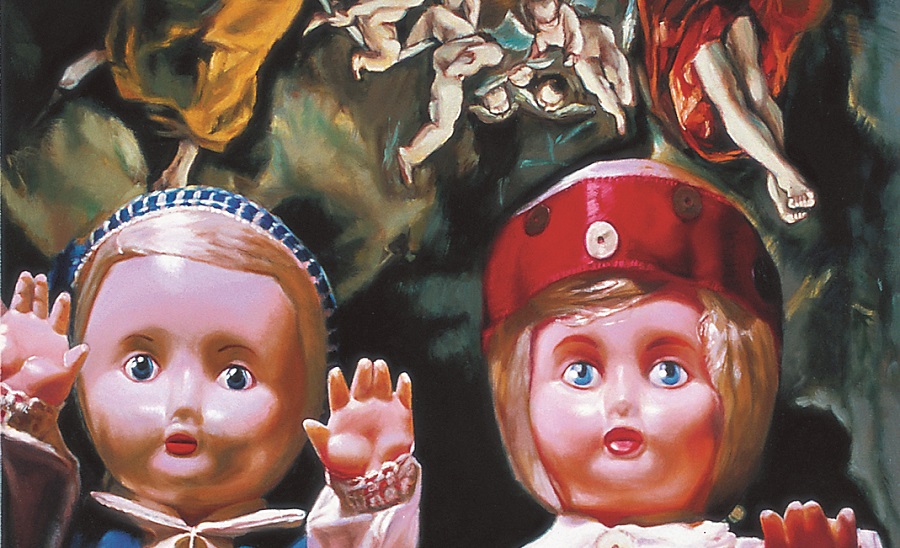Kitsch items that may nevertheless enshroud memories of childhood or a distant homeland, Aerfeldt's dolls present a tragi–comic duality.
Christine Aerfeldt
Born 1958, Adelaide South Australia
Christine Aerfeldt's profoundly personal early paintings integrated nostalgic sepia–coloured paintings of old family photographs from Estonia, with bright and polished depictions of kitsch Hummel–like dolls in traditional and beautifully–detailed European folkloric costumes.
Adroitly manipulating scale and composition and espousing a flatness of surface, Aerfeldt paints her theatrical, brilliantly–coloured (self-described) 'psycho–dramas' – rapidly and with a consuming intensity – from digitally-manipulated images. Having experienced a Tuymans–like epiphany in the Prado Museum, for the Heav'n & Hell series (2004), Aerfeldt appropriated and rearranged old–master allegorical imagery, such as El Greco's Adoration of the Shepherds (c. 1605). Depicted in reverse in Wanda and Wilhelm get up to childish tricks in the dark (2003), the phlegmatic doll duo colonise the dominant, light-drenched position, occupied by the Christ-child in the original.
Ever-experimental, Aerfeldt's focus has recently shifted to a range of different objects – albeit talismans that possess an enduringly personal or familial connection. In the dramatic work Baby owl is caught up in tangles, but whispers a soft song (2005), Miro–esque motifs surround an unblinking toy owl, perched on the elaborately coiffured head of a woman, whose reciprocal gaze is – tantalisingly – almost conceded, but ultimately denied the viewer.
Artists such as Paula Rego and Destiny Deacon have frequently inserted toys (or animals) into their narratives as a surrogate means of articulating that which may be unsayable. Kitsch items that may nevertheless enshroud memories of childhood or a distant homeland, Aerfeldt's dolls present a tragi–comic duality.' Their robotic play is a repertoire of richly superficial theatrical effects, a sort of burlesque of autobiographical sentiment and cultural memory.' (1) Still, the impression lingers that Aerfeldt's creatures and figurines may well be participants in a more veiled and gritty narrative of cultural/geographical displacement.
1 Edward Colless in the exhibition catalogue for Heav'n and Hell, Helen Gory Gallery, Melbourne, 2004.
Wendy Walkerfrom from her Samstag catalogue essay, The memorable: ephemeral
2006 Anne & Gordon Samstag International Visual Arts Scholarship
2006 MA in Fine Art, Chelsea College of Art & Design, London, UK
2001 Bachelor of Visual Art (Honours), Adelaide Central School of Art
1980 Bachelor of Education (Art Teaching), Adelaide College of Arts and Education
Artist's website
www.aerfeldt.com

